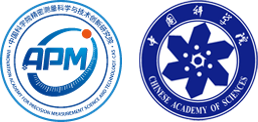

Dr. Ruhuai Mei from Max Planck Institute for Multidisciplinary Sciences, Germany Visited APM
On December 27, 2024, Dr. Ruhuai Mei from the Max Planck Institute for Multidisciplinary Science in Germany was invited to visit the Innovation Academy for Precision Measurement Science and Technology (APM) of Chinese Academy of Sciences and gave a lecture entitled "Hyperpolarization of 15N-pyridinium by Using Parahydrogen Enables Access to Reactive Oxygen Sensors and Pilot In Vivo Studies". The report was chaired by Researcher Shizhen Chen .
Dr. Mei focuses his research on synthesis of organic chemistry, electrochemical organic synthesis, and the development of parahydrogen-induced hyperpolarized isotope-labeled NMR probes. He has published 37 SCI papers, which have been cited over 2,100 times.
In his lecture, Dr. Mei first introduced hyperpolarization techniques, including dynamic nuclear polarization and parahydrogen-induced polarization. Subsequently, the method of detecting reactive oxygen in vivo through hyperpolarization technology of parahydrogen-induced polarization side arm hydrogenation was discussed. Commencing with the fundamental principles of parahydrogen, Dr. Mei meticulously outlined the process of parahydrogen hyperpolarization. A further discussion was conducted regarding the requirements for detecting hyperpolarized substrates of reactive oxygen, highlighting the remarkable efficacy of the parahydrogen-induced polarization side arm hydrogenation method in amplifying substrate polarization and its impressive capacity to discern different concentrations of H2O2. To further verification, Dr. Mei conducted a groundbreaking mouse study utilizing purified hyperpolarized substrates, successfully achieving in vivo detection of 15N substrates. The presentation concluded with a comparison of results from different technologies and a thorough discussion on the challenges associated with integrating reactive oxygen detection with parahydrogen hyperpolarization technology.
After the lecture, Dr. Mei engaged in in-depth discussions with teachers and students, further enhancing their understanding of parahydrogen hyperpolarization to achieve reactive oxygen detection.


Innovation Academy for Precision Measurement Science and Technology, CAS.
West No.30 Xiao Hong Shan, Wuhan 430071 China
Tel:+86-27-8719-8631 Fax:+86-27-8719-9291
Email:hanyeqing@wipm.ac.cn
鄂ICP备15017570号-1